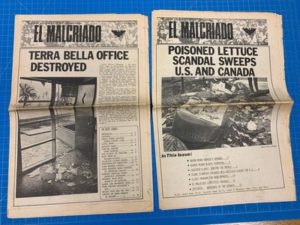The end of the Fall 2019 semester is rapidly approaching. The air is colder, and deadlines are looming ever closer. Fortunately, I can report that the duties of my fellowship are nearly complete. The data for the now processed second half of the Matt Garcia Papers has been imported to the cloud program ArchivesSpace, and I merged the two halves into one list of folder titles arranged alphabetically. Soon, the completed finding aid will be available on the Online Archive of California (OAC).
At this point, the only daunting task on my horizon is the presentation to the library staff. I have not had to write extensive series collection summaries or a biographic history, as most of the front matter was completed after the first half of the processing was finished in 2018. I simply must rewrite a few entries and add the relevant information regarding the new items in the collection. The finish line is in sight.
With that in mind, I hope everyone has a lovely week off class. Let us return refreshed and prepared for a strong finish to Fall 2019. Happy Thanksgiving!
One final note, I included images of the UFW publication I mentioned last week below. I am not exactly a technological savant, so I couldn’t get the images to look right. Alas, I figured it out. Enjoy!

